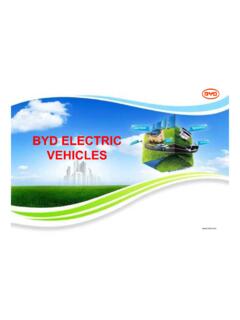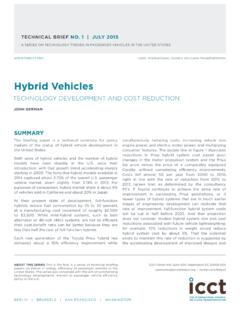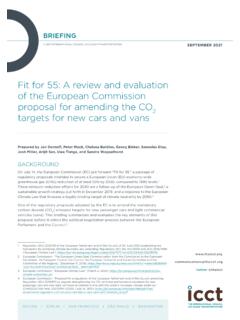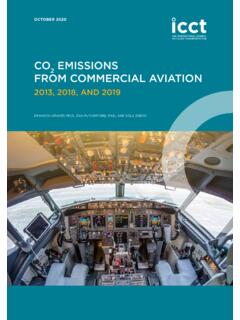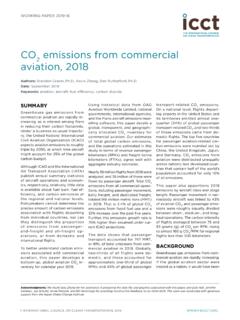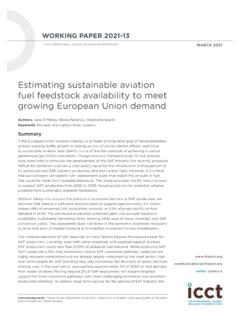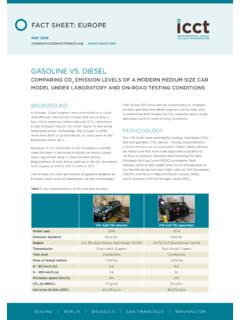Transcription of Literature review of electric vehicle consumer awareness ...
1 INTERNATIONAL COUNCIL ON CLEAN TRANSPORTATION, 2017 Literature review of electric vehicle consumer awareness and outreach activitiesAuthors: Lingzhi Jin, Peter SlowikDate: March 21, 2017 Keywords: electric vehicles; consumer awareness ; internationalI. IntroductionGovernments around the world are implementing policies to promote electric vehicles to reduce dependence on oil, decrease greenhouse gas emissions, and improve air quality. In the past few years, annual global electric vehicle sales have been firmly on the upswing, from just hundreds in 2010 to over 500,000 in 2015 and over 750,000 in 2016. The cumulative global market reached the milestone of 1 million electric vehicles in September 2015, and from there quickly grew to 2 million in January 2017.
2 The early market growth for electric vehicles continues, but a number of barriers prevent their more widespread uptake. These barriers include the additional cost of the new technology, the relative convenience of the technology considering range and charge times, and consumer understanding about the availabil-ity and viability of the technology. This last point, typically referred to as consumer awareness , is crucial. The development of electric vehicle markets is fundamentally tied to pro-spective consumers general awareness and understanding of the potential benefits of electric at national and local levels, automobile manufacturers and dealers, electric utilities, and other groups are engaged in many activities to help overcome barriers to consumer awareness about electric vehicles.
3 These communication efforts include developing print and online infor-mation and tools, organizing public events and workshops, increasing exposure to electric vehicles from fleet and carsharing services, developing action plans for electric vehicle readiness, executing highly visible technology demonstration projects, conducting social media marketing campaigns, and more. These actions are essential because many pro-spective consumers generally lack strong understanding of what electric vehicles are, what benefits they offer, the models that are available, and the associated incentives. This paper reviews global practices on electric vehicle consumer awareness activities in order to explore actions that governments can take to foster growth of the market and understand how to better implement such campaigns.
4 It summarizes practices in consumer education, awareness , and outreach regarding electric vehicles. We examine Literature that identifies and discusses the importance of consumer awareness , catalogue the range of awareness and outreach activities in place in key electric vehicle markets, identify exemplary actions in leading electric vehicle markets, and provide additional discussion for several case information in this report comes from governments and nongov-ernmental organizations websites, published research, reports and surveys, online news articles and blogs, and websites for specific programs/actions. Section II reviews the Literature that has focused on identi-fying and determining the importance of consumer awareness . Section III discusses exemplary actions in leading electric vehicle markets.
5 Section IV offers additional discussion of five case studies to provide further details on some of the more mature consumer -oriented electric vehicle campaigns. II. Background on electric vehicle consumer awareness activitiesThis section reviews the research Literature related to the importance of consumer awareness activities in WORKING PAPER 2017-03 Acknowledgements: This work is conducted for the International Zero-Emission vehicle Alliance and is supported by its members. Members of the International Zero Emission vehicle Alliance provided key inputs on electric vehicle activities and campaigns. Nic Lutsey supported and reviewed the review OF electric vehicle consumer awareness AND OUTREACH ACTIVITIES 2 INTERNATIONAL COUNCIL ON CLEAN TRANSPORTATION WORKING PAPER 2017-03encouraging the adoption of electric vehicles.
6 Based on the Literature , we identify specific actions imple-mented around the world to promote consumer awareness and understand-ing. Finally, this section provides an initial catalogue of the various outreach activities that are in place in leading electric vehicle markets. IMPORTANCE OF consumer AWARENESSS everal studies have found that there is a general lack of knowledge and awareness about electric vehicles. For example, less than half of consumers are able to name a specific plug-in electric vehicle make and model (Singer, 2015), and less than 35% of California households are aware of incentives offered for the purchase of electric vehicles (Kurani & Tal, 2014). In a survey of 21 cities (Krause, 2013), about two-thirds of the respondents had misunderstandings about the basic characteristics of plug-in electric vehicles, and about 95% of them were not aware of available incentives.
7 An IBM consumer survey (Gyimesi & Viswanathan, 2011) similarly found that 45% of the surveyed drivers had little to no understanding of electric vehicles. Federal incentives in the United States amount to up to $7,500 per electric vehicle , and additional state incentives typically amount to more than $2,000. These, and similarly sub-stantial incentives globally (see Yang et al., 2016), are meant to overcome the critical cost barrier to electric vehicles. The Kurani et al. (2016) study found that only 49% of California new-car buyers were aware of the federal tax incentive, and only about 33% were aware of California s state-level incentive. Nationwide, only 44% of people were aware of the federal tax incentive. Of the consumers who could correctly name any plug-in electric vehicle model, 95% of the respondents could only name either the Nissan Leaf or Tesla Model S, indicating low awareness about the diversity of available models.
8 Consumers who have exposure to electric vehicles are more likely to value them more highly and consider them as a choice for future purchases (Kurani et al., 2016; Larson, 2014; Gyimesi & Viswanathan, 2011). A survey by consumer Federation of America (CFA, 2015) revealed that greater consumer knowledge about electric vehicles and their desire to purchase one are correlated. However, only 21% of the respondents said they know a fair amount about electric vehicles, and far fewer reported knowing a great deal about them. In a paper examining e-mobility in Stuttgart, Germany, Reiner & Haas (2015) note that as people have more experience driving an electric vehicle , they show more favorable attitudes towards e-mobility. A study by Kannstatter & Meerschiff (2015) in Europe found that 71% of participants expressed interest in considering an imminent purchase of an electric vehicle after a test drive.
9 In another study (Bunce et al., 2014), the number of drivers who were willing to pay a premium for a more environ-mentally friendly vehicle jumped from 51% to 74% after exposure to the Ultra Low Carbon vehicle campaign in the United Kingdom. Table 1 summarizes Literature that identifies the importance of consumer awareness for electric vehicles. The Literature include results from surveys, interviews, trials, and synthesis reports from various other programs. Some of the research gives a cross-sec-tional/snapshot view of consumers knowledge of electric vehicles ( , Singer, 2015). Other work connects consumer awareness of electric vehicles to their evaluation of the vehicles and how likely they are to consider them as a purchase option ( Kurani et al.)
10 , 2016; Gyimesi & Viswanathan, 2011; CFA, 2015). Other reports compare consumer perception before and after a test drive or a longer trial period (Kannstatter & Meerschiff, 2015; Bunce, 2013). Overall, these studies show that general consumer awareness of electric vehicles is relatively low, and this includes lack of familiarity with the new technology, lack of knowledge of available incentives and models, and mispercep-tion about the potential savings from lower fuel and maintenance costs. In general, consumers with greater knowledge or experience are more likely to value electric vehicles higher, consider electric vehicles as a future purchase option, and be willing to pay a premium for the OF consumer OUTREACH AND awareness ACTIVITIESA wide variety of activities are in practice that help to reduce consumer barriers related to understanding and awareness of electric vehicles.

